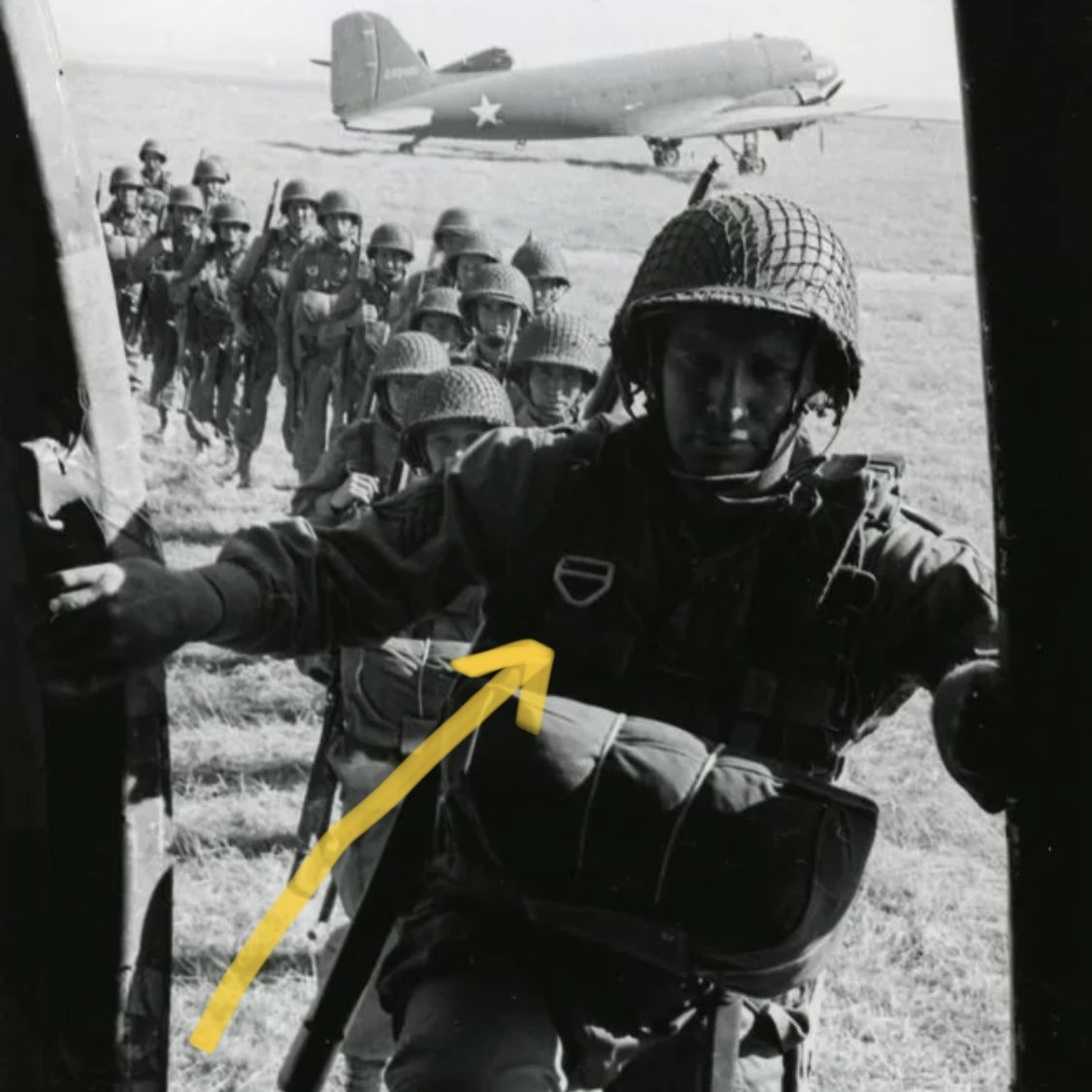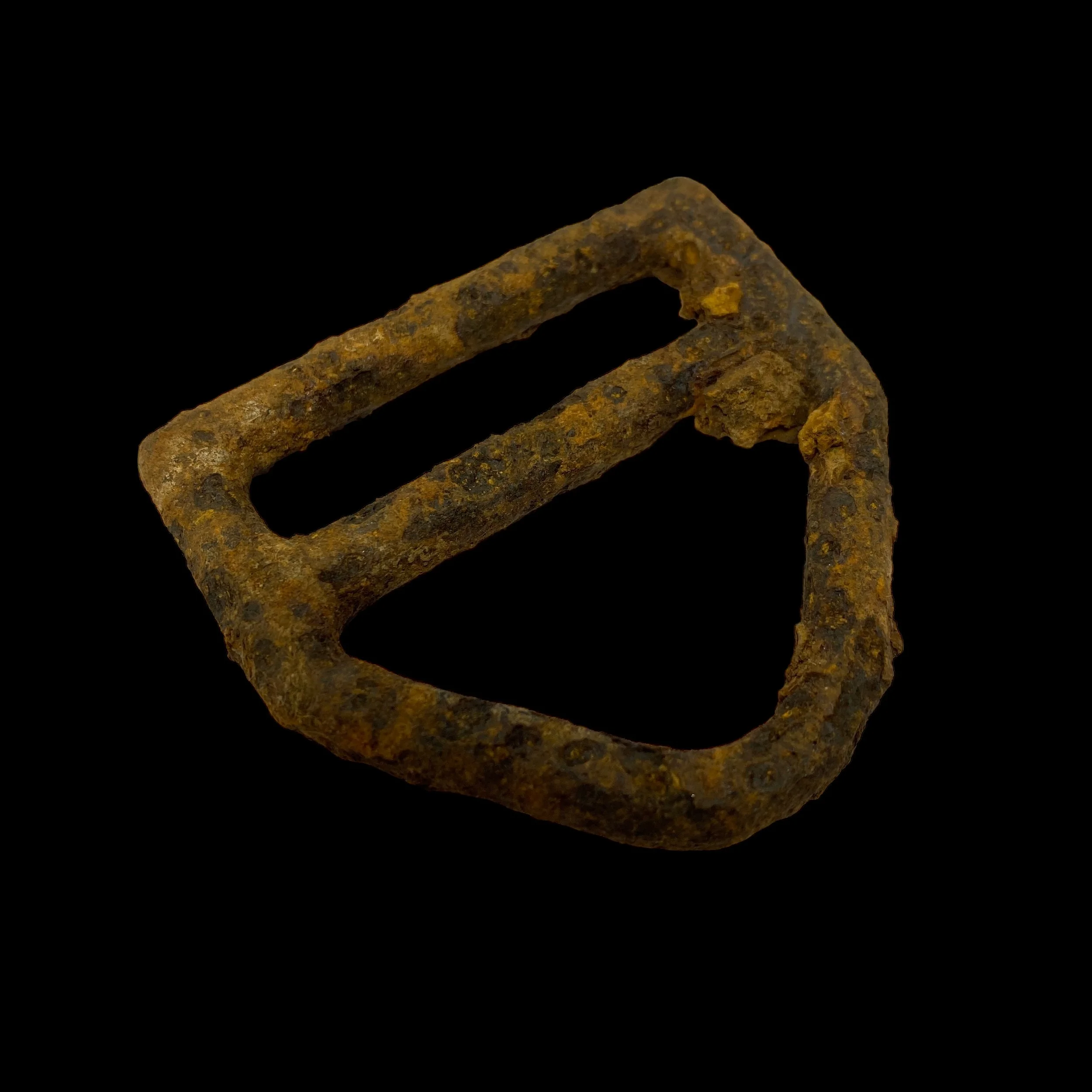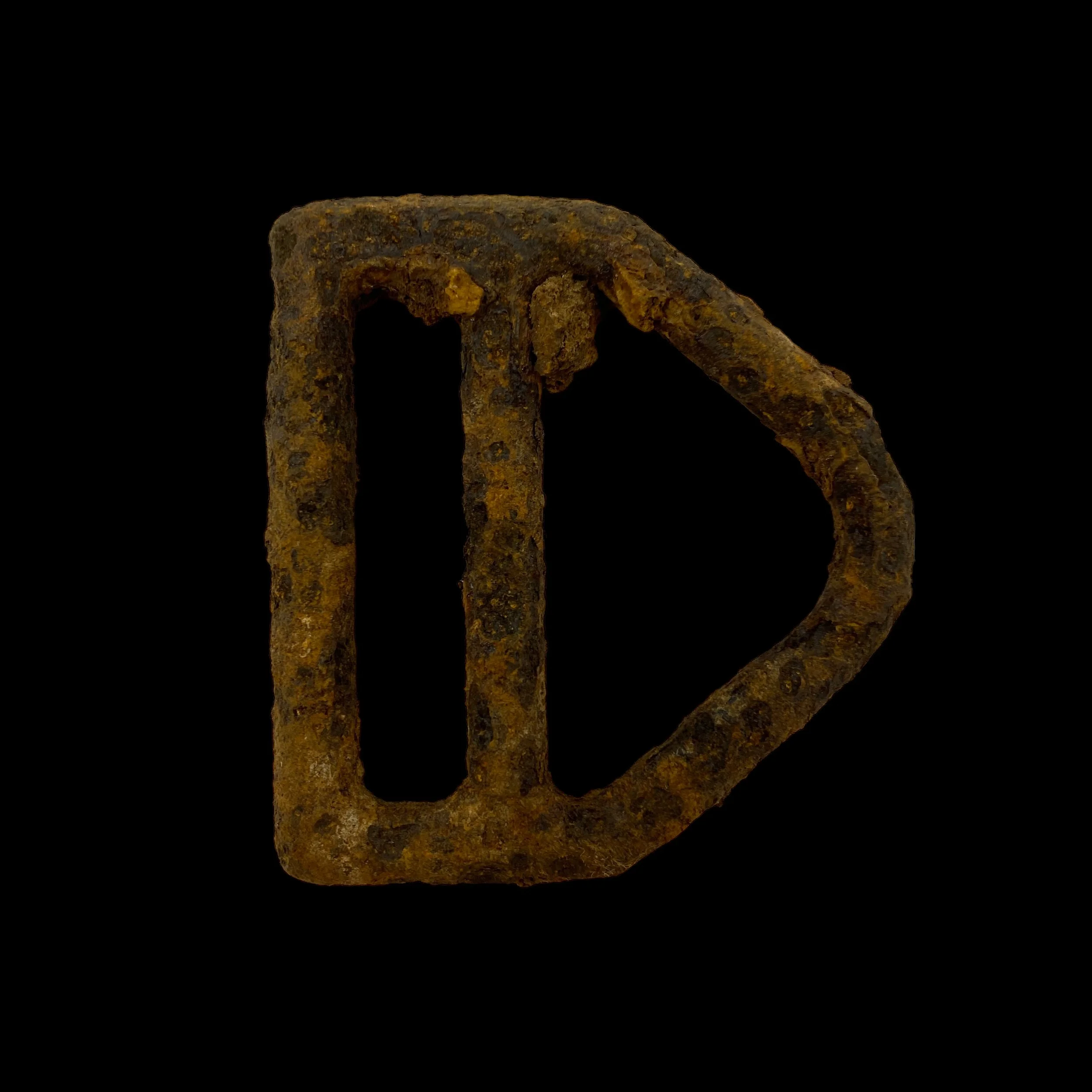RARE! 1944 WWII 101st Airborne Division US Paratrooper Parachute Hook Recovered Operation Market Garden Battlefield (101st DROP ZONES)







RARE! 1944 WWII 101st Airborne Division US Paratrooper Parachute Hook Recovered Operation Market Garden Battlefield (101st DROP ZONES)
Comes with hand-signed C.O.A.
This incredibly rare and museum-grade WWII artifact is an original 101st Airborne Division parachute harness that was recovered from the Operation Market Garden battlefield and 101st Airborne Division designated drop zones.
On September 17th, 1944, in broad daylight, the 101st Airborne Division parachuted into Holland in a bold strike in order to seize bridges across rivers and adjacent canals from Belgium to Arnhem.
The 101st Airborne Division had to secure bridges over the river Dommel in Eindhoven, bridges over the Wilhelmina canal in Son and Best and bridges over the Zuid-Willemsvaart and river AA in Veghel.
This 101st Airborne parachute harness hook was recovered during a professional excavation of DROP ZONE A, DROP ZONE A-1, DROP ZONE B, DROP ZONE C, and DROP ZONE W.
The plan of action consisted of two operations:
Market: airborne forces of Lieutenant General Lewis H. Brereton's First Allied Airborne Army to seize bridges and other terrain, under tactical command of I Airborne Corps under Lieutenant-General Frederick Browning, and…
Garden: ground forces of the Second Army to move north spearheaded by XXX Corps under Lieutenant-General Brian Horrocks.
“Market” would be the largest airborne operation in history, delivering over 34,600 men of the 101st, 82nd and 1st Airborne Divisions and the Polish Brigade. 14,589 troops were landed by glider and 20,011 by parachute. Gliders also brought in 1,736 vehicles and 263 artillery pieces. 3,342 tons of ammunition and other supplies were brought by glider and parachute drop.
The name of the 101st Airborne Division US paratrooper that used this parachute harness hook during the Operation Market Garden drops will remain lost to history. This artifact severe a solemn reminder of the men that sacrificed their lives jumping into enemy-occupied territory to pave the way for the incoming gliders and advancing Allied Infantry and Armored Divisions.
FULL COMBAT TIMELINE OF THE 101st DURING OPERATION MARKET GARDEN:
17 September 1944:
The 101st Airborne Division assigned four drop zones to land paratroops and one landing zone for gliders. The main force of the 501st Parachute Infantry Regiment and elements of the 326th Airborne Engineers Battalion were the first to land at drop zone A (see map) at Eerde. 1st Battalion was assigned to Drop zone A1, just west of Veghel, in between the Aa river and the Zuid-Willemsvaart. The pathfinder stick for drop zone A made a perfect jump over the drop zone and set up their beacons for the Troop Carrier serials within 30 minutes. The other Pathfinder stick for drop zone A1 was shot down over Retie (Belgium), therefore 1st Battalion wasn’t able to find the right drop zone. They were misdropped at Kameren, on the grounds of Heeswijk Castle and the surrounding meadows. The grounds around the castle were far from an ideal drop zone, therefore 1st battalion suffered a lot of jump casualties. The wounded were left behind at the castle and 1st battalion marched towards Veghel, which was located 5 miles to the east. 2nd and 3rd battalion of the 501st and the engineers marched to the bridges quickly and soon they captured the two railway bridges at Veghel and the two road bridges. They set up roadblocks at Veghel and Eerde.
All the other units of the 101st Airborne Division were assigned to Drop zone B and C and Landing zone W (see map). The 502nd Parachute Infantry Regiment jumped on drop zone B, the 506th Parachute Infantry Regiment on drop zone C. Elements of the 326th were assigned to both regiments. On landing zone W, 53 gliders landed containing the 326th Airborne Medical Company, jeeps and elements of signal corps, recon and HQ. The rest of the glider landings were scheduled for the following days.
The 502nd were assigned with the task of capturing the Dommel bridges at Sint-Oedenrode, the bridge at Best over the Wilhelmina canal and protect the drop- and landing zone(s) at Son. They were able to seize the bridges at Sint-Oedenrode, set up positions at the drop zone, but received heavy enemy resistance at Best. Later in the afternoon, Colonel John Michaelis, commander of the 502nd, ordered more troops to move towards Best but it didn’t help. The troops at Best had to dig in for the night and try to capture the bridge the following day.
The 506th had to capture the bridge over the Wilhelmina canal at Son and move further south to Eindhoven and secure four bridges over the Dommel river. They achieved none of their tasks on the 17th. They assembled quickly, marched towards Son but were met by a German 88 mm gun in the center of Son which stopped the advance. 1st Battalion tried to bypass the town on the west and flanked the German position, but they were stopped by two 88 mm guns positioned at the canal, inflicting many casualties in the ranks of the paratroops. The paratroopers of the 506th moved up the main road quickly, took out the 88 mm guns and forced their way towards the bridge. The enemy had halted the troops of the 506th long enough to wire the bridge with explosives and once the first paratroopers neared the bridge, they blew it up sky high. The engineers prepared a small wooden bridge over the canal and two battalions crossed, but it wasn’t big enough to get the battalions across quickly. Colonel Robert Sink, commander of the 506th ordered his troops to dig in just south of the canal, they would try to take Eindhoven the next day.
18 September 1944:
In the morning the 506th assembled 2nd and 3rd battalion and moved out towards Eindhoven. 1st Battalion had suffered many casualties at Son and would follow the main force later in the afternoon. It didn’t take long for the Germans to respond to the attacking force. On the outskirts of Eindhoven the paratroops were met by 88 mm guns and heavy machine gun fire. Slowly the troops advanced and after an intense battle two 88 mm guns were destroyed, prisoners were taken and the troops continued to the bridges. The four bridges over the Dommel river were taken without a fight and the 506th formed a defensive perimeter. Early in the afternoon two armored cars from XXX-corps linked up with troops of the 506th at the Woenselsestraat. First contact was made but sadly the paratroopers had to report that the bridge at Son was lost. At around 19.00 hours, the main force of XXX-corps arrived in Eindhoven linking up with the troops of the 506th. Engineers of XXX-corps were sent forward towards the bridge at Son to place a Bailey bridge over the Wilhelmina canal.
The lines of the 501st at Veghel and the 502nd at Sint-Oedenrode were tested by the enemy but the paratroops were able to withstand the probing attacks. Elements of the 502nd at Best were still stuck at Best, encountering heavy enemy resistance from infantry, 88 mm and 20 mm guns. General Maxwell Taylor, commander of the 101st Airborne Division, thought that the bridge at Best wasn’t necessary when he made his Market Garden attack plan in England and had only send a small force to capture it the day before. With the bridge at Son now gone, the bridge at Best was a very good alternative. In the afternoon, 2nd Battalion of the 502nd was sent to support the attack of 3rd battalion on Best. But even two battalions weren’t enough to get the upper hand. Only a small unit consisting of Company H and engineers had been able to get within range of the bridge the day before. They witnessed the Germans blowing up the bridge at 11.00 hours, but were unable to pass it through to battalion.
At 13.00 hours, the next serial of gliders landed on Landing zone W, flying in elements of the 327th Glider Infantry Regiment, artillery and other supporting units of the 101st Airborne Division. These landings were very successful.
19 September 1944:
During the night the British engineers worked hard to finish the Bailey bridge at Son. In the morning, the 506th in Son witnessed the first tanks of XXX-corps crossing the canal. With tanks now rolling through Eindhoven and Son, the paratroopers of the 506th were able to patrol the area and widen the corridor. In the afternoon the bridge at Son was attacked by tanks and infantry of the German 107th Panzer Brigade. Troops of the 327th, 506th and supporting units formed a defensive line to fence of the attack. A short but fierce fight took place at the bridge, the paratroopers weren’t equipped properly to fight tanks. Luckily just before the tanks arrived, troops of the 81st Anti-aircraft Anti-tank Battalion landed on the drop zone at Son and anti-tank guns were hauled off the drop zone and towed to the bridge at Son. With AT guns and bazooka’s, the paratroopers were able to destroy some enemy tanks. They attack halted and the Germans pulled back. No damage was done to the newly created Bailey bridge and tanks rumbled on towards Arnhem.
Troops of the 506th in Eindhoven received their marching orders. 2nd battalion was sent to Helmond, Mierlo and Nuenen. 3rd battalion moved out towards Wintelre, Oerle, Veldhoven and the airfield west of Eindhoven. 2nd battalion didn’t get very far. They bumped into troops of the 107th Panzer Brigade and were overwhelmed. They quickly retreated back towards Eindhoven.
On landing zone W more supporting units of the 101st Airborne Division landed, including artillery and anti-tank units. Also, the rest of the 327th Glider Infantry Regiment was flown in by the Troop Carrier groups. 2nd and 3rd battalion of the 502nd was still stuck at Best. Taylor asked for tank support of the 15/19 Hussars. This British unit formed a combat team with the 2nd and 3rd battalion of the 327th and was sent to Best to support the 502nd. Almost half the division was stuck in the fight at Best and with the new reinforcements, the area around the Best bridge was finally secured. With the support of tanks, German defenses at Best collapsed quickly and many 88 mm guns were destroyed and hundreds of prisoners were captured.
In the meantime the 501st at Eerde and Veghel was faced by a strong German attacking force. The Germans attacked from the West sending in troops from the Schijndel area. The fighting force (Kampfgruppe) consisted of regular infantry, Luftwaffe troops but also troops of the elite Fallschirmjäger Regiment 6, which had fought XXX-corps at Neerpelt two days earlier. The 501st was pushed out of Eerde and they set up defensive lines at Veghel.
In the evening of the 19th, the sky above Eindhoven was lit by flares. Suddenly planes were heard, but this time it weren’t allied planes flying in paratroops, but German bombers. The Luftwaffe was ordered to attack the corridor by bombing the narrow streets in the city of Eindhoven. Over 230 civilians were killed during the bombing raid and hundreds more were injured.
Today, the troops of XXX-corps and the 101st Airborne Division experienced that the German army wasn’t defeated yet.
20 September 1944:
Company C of 1st battalion 501st Parachute Infantry Regiment were sent to the castle at Heeswijk to see if the wounded troops that were left behind were still there, but no one was found. Colonel Harry Kinnard, commander of 1st Battalion of the 501st, ordered Company C to dig in while company A and B attacked westward from Veghel towards Heeswijk. The patrol group acted as a dustpan while the attackers acted as a broom, cleaning the area of German paratroops in between the Aa river and Zuid-Willemsvaart canal. The attack was very successful and a lot of ground was gained. With the attack 1st battalion captured over 400 enemy troops. 2nd battalion was held in Veghel, while 3rd battalion moved back into Eerde again.
The troops at Son were again under attack by tanks of the 107th Panzer Brigade. They didn’t attack in full force, but shot at the column moving up north from afar, taking out numerous vehicles. The enemy tanks at Son eventually pulled back, but the fighting all along the corridor continued throughout the day.
21 September 1944:
1st and 3rd battalion of the 501st was ordered by Lt-Col Howard Johnson, commander of the 501st, to attack Schijndel at night. Very early in the morning the attack started. 3rd battalion attacked Schijndel coming from Eerde, while 1st battalion moved in from Dinther. The attack soon halted but ground was held.
The 502nd was still under enemy attacks in Sint-Oedenrode, coming in from the west at the Ollandseweg. They received tank support but the Germans were able to take out some armor. The corridor was still under pressure.
With the 107th Panzer Brigade still somewhere in between Eindhoven and Son, the paratroopers of the 506th together with tanks of XXX-corps were sent towards Nederwetten. Now the tanks were able to clear the area of enemy troops.